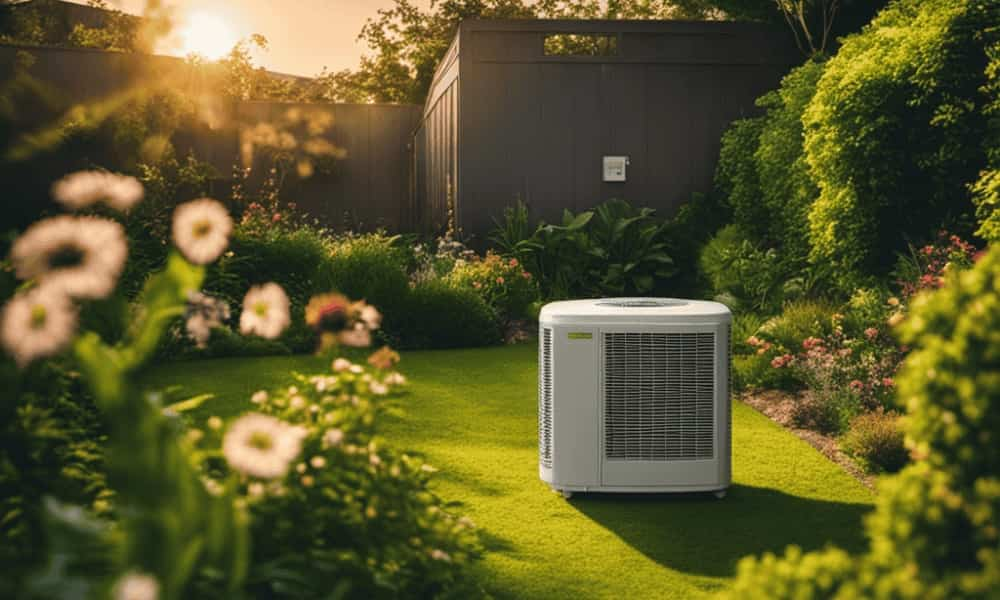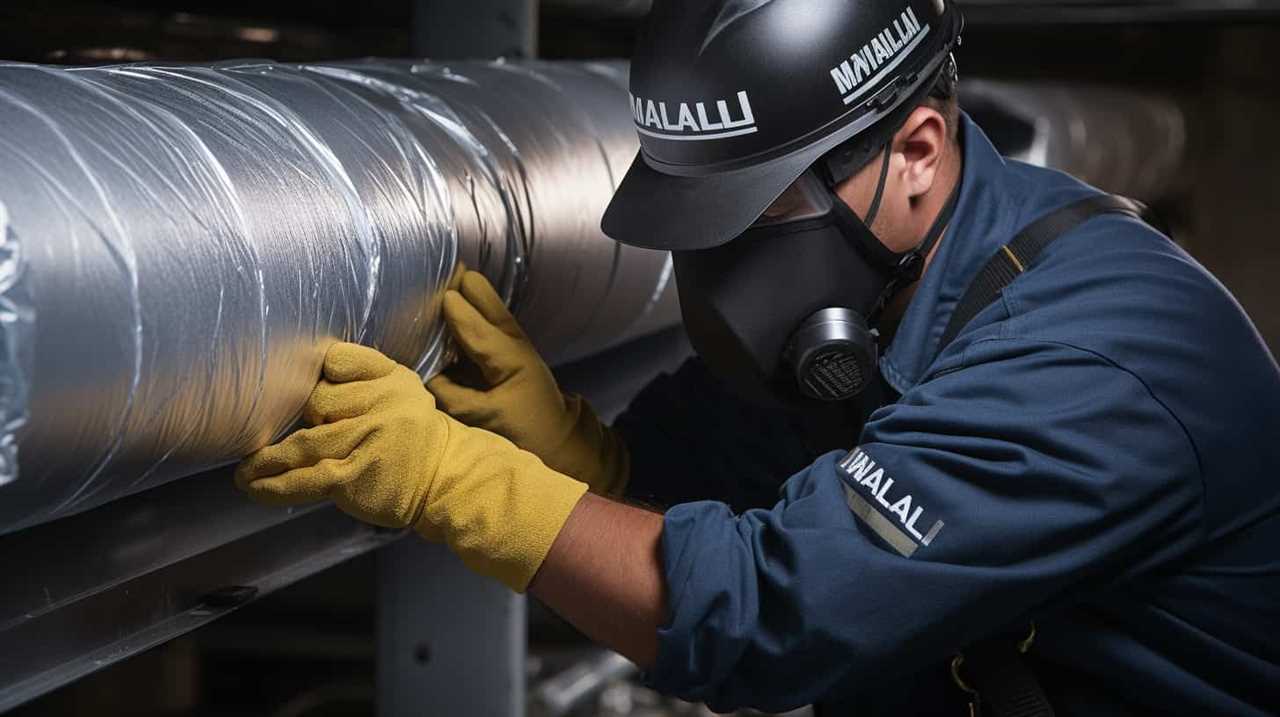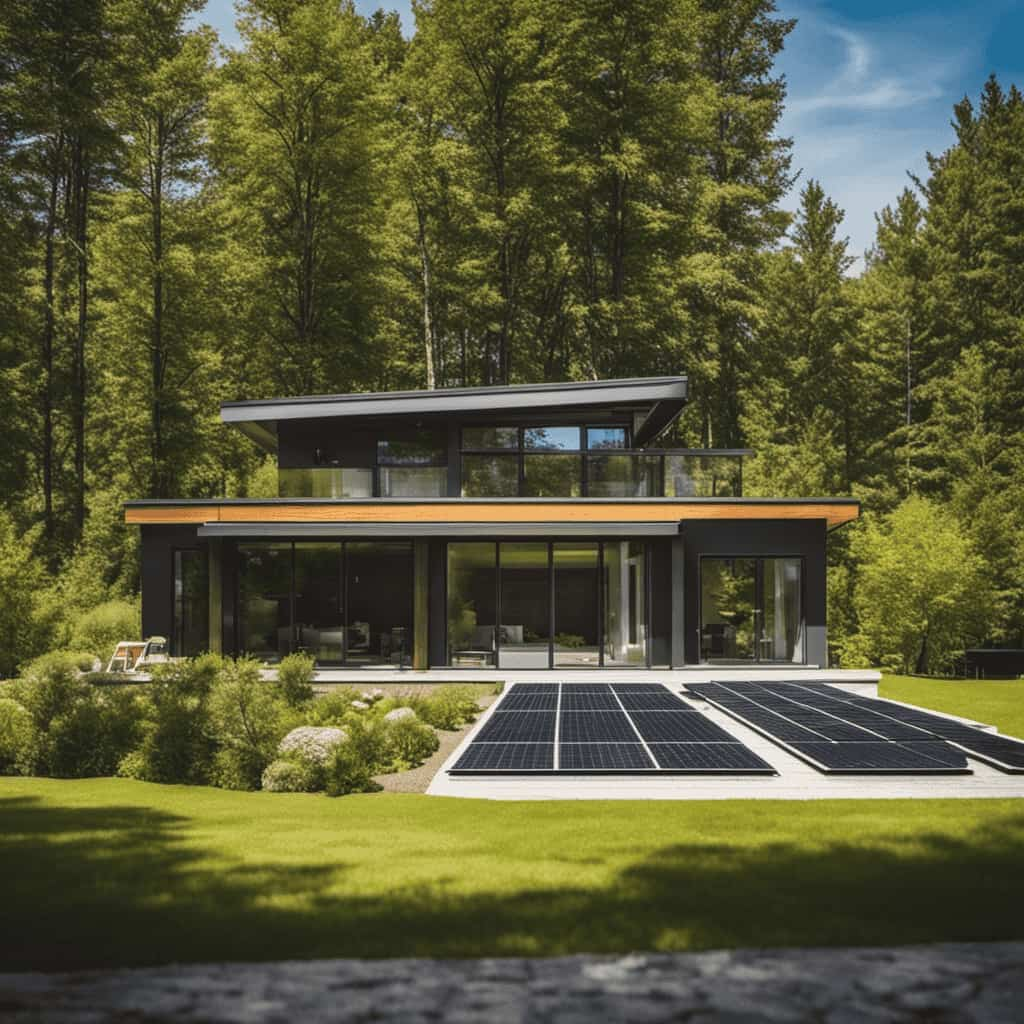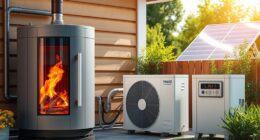Here’s an intriguing fact for you: heat pumps are revolutionizing the transition toward renewable energy.
With their ability to efficiently convert energy and reduce carbon emissions, heat pumps are leading the way towards a cleaner and more sustainable future.
In this article, we’ll delve into the benefits, basics, cost-effectiveness, and environmental impact of heat pumps in renewable energy systems.
We’ll also explore government incentives, successful case studies, maintenance tips, and future trends to keep you informed and inspired in your journey towards adopting renewable energy.

Key Takeaways
- Heat pumps significantly reduce greenhouse gas emissions compared to traditional heating systems.
- Heat pumps have a high coefficient of performance, meaning they produce more energy output than the input they require.
- Heat pumps offer long-term savings potential through reduced energy consumption.
- Incentives and rebates offered by governments and utility companies reduce upfront costs and improve return on investment.
The Benefits of Heat Pumps in the Transition to Renewable Energy
We can maximize the benefits of heat pumps in our transition to renewable energy by effectively utilizing and integrating them into our heating systems.
Heat pumps play a crucial role in reducing carbon emissions and improving energy efficiency. According to recent data, heat pumps have the potential to significantly reduce greenhouse gas emissions compared to traditional heating systems. By harnessing the natural heat from the environment, heat pumps can provide heating and cooling with minimal energy consumption. This not only lowers our carbon footprint but also contributes to achieving our sustainability goals.
Additionally, heat pumps have a high coefficient of performance, meaning they can produce more energy output than the input they require. This translates to increased energy efficiency and cost savings.
Understanding the Basics of Heat Pumps and Renewable Energy
Maximizing the benefits of heat pumps in our transition to renewable energy involves understanding their basics and effectively integrating them into our heating systems. When evaluating efficiency, it’s important to consider the Coefficient of Performance (COP) of a heat pump. This ratio compares the amount of heat generated to the energy consumed. Higher COP values indicate greater efficiency. Technology advancements have led to significant improvements in COP, making heat pumps an attractive option for renewable energy.

Additionally, understanding how heat pumps work is crucial. Heat pumps extract heat from the air, ground, or water, and transfer it to the desired location using a refrigerant. By utilizing this renewable heat source, they can provide efficient heating and cooling.
Now, let’s move on to evaluating the cost-effectiveness of heat pumps for renewable energy.
Evaluating the Cost-Effectiveness of Heat Pumps for Renewable Energy
When considering the cost-effectiveness of heat pumps for renewable energy, it’s important to compare their costs to traditional heating systems.
Heat pumps can be initially more expensive to install, but they offer significant long-term savings potential through reduced energy consumption.

Cost Comparison: Heat Pumps Vs. Traditional Heating
Comparing the costs, heat pumps offer a more cost-effective alternative to traditional heating methods for renewable energy. In terms of cost comparison, heat pumps have a higher upfront cost compared to traditional heating systems. However, their energy efficiency and long-term savings make them a more economical choice in the long run.
Heat pumps are highly energy-efficient, converting a small amount of electricity into a large amount of heat. This efficiency is measured by the Coefficient of Performance (COP), which indicates the ratio of heat output to electrical input. Heat pumps typically have COP values ranging from 2 to 4, meaning they can produce 2 to 4 units of heat for every unit of electricity consumed.
In contrast, traditional heating methods, such as gas furnaces or electric resistance heaters, have lower energy efficiency. Gas furnaces have an average efficiency of 80%, while electric resistance heaters have a COP of 1, meaning they produce only as much heat as the electricity consumed.
Considering the energy efficiency of heat pumps and their ability to provide both heating and cooling, they offer significant cost savings over traditional heating methods. Heat pumps can reduce energy consumption by up to 50% compared to gas furnaces or electric resistance heaters. This translates to lower utility bills and reduced carbon emissions.

Moreover, heat pumps benefit from the advancements in renewable energy sources. By harnessing electricity from solar panels or wind turbines, the operating costs of heat pumps become even more cost-effective. The abundance of renewable energy sources further promotes the affordability and sustainability of heat pumps.
Long-Term Savings Potential
For evaluating the cost-effectiveness of heat pumps for renewable energy, we need to consider their long-term savings potential. Here are four key factors to consider in determining the cost analysis and return on investment of heat pumps:
Energy Efficiency: Heat pumps are highly efficient, converting a small amount of electricity into a large amount of heat. This efficiency leads to reduced energy consumption and lower utility bills over time.
Maintenance and Lifespan: Heat pumps require regular maintenance, but their long lifespan ensures that the initial investment pays off in the long run. Proper maintenance can extend the lifespan of a heat pump, maximizing its cost-effectiveness.

Incentives and Rebates: Many governments and utility companies offer incentives and rebates for installing heat pumps, reducing the upfront cost and improving the return on investment.
Future Energy Prices: As the cost of traditional energy sources continues to rise, the use of heat pumps becomes even more cost-effective. By relying on renewable energy sources, heat pumps offer a hedge against future energy price increases.
Considering these factors, heat pumps present a compelling long-term savings potential and a wise investment for those seeking cost-effective renewable energy solutions.
Choosing the Right Heat Pump for Your Renewable Energy Needs
We should consider the factors that are important in choosing the right heat pump to meet our renewable energy needs. Heat pump sizing is a critical aspect to consider when selecting a heat pump. It’s essential to choose a heat pump that’s properly sized for the heating and cooling demands of our space. Undersized heat pumps may struggle to meet the desired temperature, while oversized heat pumps can result in inefficiency and unnecessary energy consumption.

Additionally, installation considerations play a crucial role in the selection process. Factors such as available space, electrical requirements, and the layout of our property should be taken into account to ensure a smooth installation process.
By carefully considering heat pump sizing and installation considerations, we can make an informed decision that maximizes the efficiency and effectiveness of our renewable energy system.
Transitioning into the next section, let’s now explore the environmental impact of heat pumps in renewable energy systems.
The Environmental Impact of Heat Pumps in Renewable Energy Systems
When considering the adoption of renewable energy systems, it’s important to understand the environmental impact of heat pumps.

Heat pumps offer a more sustainable alternative to traditional heating and cooling systems, but they aren’t without their own environmental considerations.
Here are four key points to consider regarding the environmental impact of heat pumps in renewable energy systems:
Life cycle: Heat pumps have a longer lifespan compared to other heating and cooling systems, resulting in reduced waste and resource consumption.
Energy efficiency: Heat pumps are highly efficient, converting a small amount of electricity into a larger amount of heat or cool air, resulting in lower energy consumption and reduced carbon emissions.

Carbon footprint: Heat pumps produce fewer greenhouse gas emissions compared to fossil fuel-based systems, contributing to a lower carbon footprint.
Refrigerants: Some heat pumps use refrigerants with high global warming potential, which can offset their environmental benefits. However, advancements in refrigerant technology are addressing this concern.
Overcoming Challenges in the Adoption of Heat Pumps for Renewable Energy
How can we overcome challenges in adopting heat pumps for renewable energy?
In order to successfully integrate heat pumps into our renewable energy systems, we must address several key obstacles.

One major challenge is overcoming technical barriers, such as the need for adequate space for installation and compatibility with existing heating and cooling systems.
Another critical aspect is consumer education and awareness. Many individuals are unfamiliar with the benefits and functionalities of heat pumps, making it essential to provide clear and accessible information to potential adopters.
To facilitate this, we can develop comprehensive educational campaigns and resources that highlight the advantages of heat pumps for renewable energy.
By addressing these challenges head-on, we can pave the way for widespread adoption of heat pumps as a renewable energy solution.

Now, let’s explore the various government incentives and policies that can further promote the adoption of heat pumps in renewable energy systems.
Government Incentives and Policies to Promote Heat Pump Adoption in Renewable Energy
Government incentives and policies play a crucial role in promoting the adoption of heat pumps for renewable energy. These incentives can take the form of financial support, tax credits, or grants, making heat pump installations more affordable for consumers.
Policy changes, such as stricter regulations on fossil fuel heating systems or mandating energy-efficient alternatives, can also drive the shift towards heat pumps.
Understanding the effectiveness of government incentives and the impact of policy changes is essential in shaping the future of renewable energy adoption.

Effectiveness of Government Incentives
We have observed that implementing government incentives has been effective in promoting the adoption of heat pumps as a renewable energy source. Here are four reasons why:
Financial support: Government incentives, such as grants, tax credits, and subsidies, provide financial support to individuals and businesses looking to invest in heat pump technology. This reduces the upfront costs and makes heat pumps more affordable and accessible.
Awareness and education: Governments often run awareness campaigns to inform the public about the benefits of heat pumps and how they can contribute to renewable energy goals. These campaigns raise awareness and educate consumers about the incentives available to them.
Market stimulation: Government policies can create a robust market for heat pumps by setting renewable energy targets and mandating the use of heat pumps in certain sectors. This stimulates demand and encourages manufacturers to innovate and produce more efficient and affordable heat pump models.

Incentive program evaluation: Governments regularly evaluate the effectiveness of their incentive programs to ensure they’re achieving their intended goals. This evaluation helps identify areas for improvement and allows for adjustments to be made to maximize the impact of government policies.
Impact of Policy Changes
To evaluate the impact of policy changes, we must analyze the effectiveness of government incentives and policies in promoting the adoption of heat pumps as a renewable energy source. Government policies play a crucial role in driving the shift towards renewable energy, and specifically, heat pump adoption.
Policy impact can be measured by the number of heat pump installations and the overall reduction in carbon emissions. In countries where government incentives are robust, such as Germany and Sweden, the adoption of heat pumps has increased significantly. These countries have implemented policies that provide financial incentives, such as grants and tax credits, to encourage homeowners and businesses to invest in heat pump systems.
The effectiveness of these policies is evident in the rising number of installations and the subsequent reduction in greenhouse gas emissions. However, it’s important for governments to regularly evaluate and update their policies to ensure long-term effectiveness and continued growth in heat pump adoption.

Case Studies: Successful Implementation of Heat Pumps in Renewable Energy Projects
After conducting extensive research and analysis, our team has identified several successful case studies showcasing the implementation of heat pumps in renewable energy projects. These case studies highlight the potential of heat pumps as a viable solution for transitioning to renewable energy sources.
Here are four notable examples:
Citywide Heat Pump Retrofit: In a major city, existing heating systems were replaced with heat pumps in residential and commercial buildings. This resulted in a significant reduction in greenhouse gas emissions and energy consumption.
Industrial Heat Pump Integration: A large industrial facility successfully integrated heat pumps into their operations, reducing their reliance on fossil fuels and achieving substantial cost savings.

District Heating with Heat Pumps: In a district heating system, heat pumps were used to extract heat from renewable sources such as geothermal energy. This allowed for efficient heating and cooling throughout the district, reducing overall energy demand.
Heat Pumps in New Construction: Heat pumps were incorporated into the design of new buildings, providing both heating and cooling. This approach demonstrated the potential for energy-efficient and sustainable buildings.
These successful case studies demonstrate the effectiveness of heat pumps in renewable energy projects, overcoming implementation challenges and paving the way for a greener future.
Maintaining and Optimizing Heat Pumps for Long-Term Renewable Energy Use
When it comes to maintaining and optimizing heat pumps for long-term renewable energy use, there are three key points to consider: efficient heat pump operation, maintenance best practices, and ensuring longevity and reliability.

Efficient operation involves maximizing the heat pump’s performance by ensuring proper sizing, installation, and regular monitoring.
Maintenance best practices include regular inspections, filter cleaning or replacement, and refrigerant checks to ensure optimal performance.
Lastly, ensuring the longevity and reliability of heat pumps requires regular maintenance, timely repairs, and adherence to manufacturer guidelines.
Efficient Heat Pump Operation
As we explore efficient heat pump operation, it’s essential to understand how to maintain and optimize heat pumps for long-term renewable energy use. Here are four key steps to ensure efficient heat pump maintenance and improve heat pump performance:

Regularly clean and replace air filters: Dirty filters restrict airflow, reducing heat pump efficiency. Clean or replace filters every 1-3 months to maintain optimal performance.
Check and clean outdoor coils: Over time, outdoor coils can collect dirt and debris, hindering heat transfer. Regularly inspect and clean the coils to maximize heat pump efficiency.
Schedule professional maintenance: Regular maintenance by a qualified technician can identify and address any potential issues, ensuring the heat pump operates at its best.
Optimize thermostat settings: Set temperature differentials to balance comfort and energy savings. A programmable thermostat can help schedule temperature adjustments throughout the day.

Maintenance Best Practices
Let’s dive into the maintenance best practices for optimizing heat pumps for long-term renewable energy use.
Preventive maintenance is crucial for ensuring the efficiency and reliability of heat pumps. Regularly scheduled inspections and servicing help identify and address potential issues before they escalate, reducing the risk of system failure and costly repairs.
This includes cleaning or replacing filters, checking refrigerant levels, inspecting electrical connections, and lubricating moving parts.
Additionally, implementing effective troubleshooting techniques is essential for prompt identification and resolution of any operational or performance issues. This may involve analyzing system data, conducting diagnostic tests, and utilizing advanced monitoring technologies.

By adhering to these maintenance best practices, heat pump owners can maximize the lifespan and performance of their systems, ultimately contributing to the long-term reliability and sustainability of renewable energy solutions.
Moving forward, let’s explore the importance of longevity and reliability in heat pump systems.
Longevity and Reliability
Maintaining and optimizing heat pumps for long-term renewable energy use requires regular inspections and servicing to ensure longevity and reliability. To address reliability challenges and achieve optimal performance, the following steps should be taken:
Regular Maintenance: Conduct routine inspections, clean filters, and check for any leaks or malfunctions. This will help identify potential issues before they become major problems.

System Efficiency: Monitor the heat pump’s energy consumption and efficiency. Adjust settings and ensure proper insulation to maximize performance and minimize energy waste.
Professional Servicing: Engage qualified technicians to perform comprehensive servicing, including refrigerant checks, electrical component inspections, and calibration of controls.
Continuous Monitoring: Utilize smart technology and monitoring systems to track performance and detect any deviations or abnormalities. This allows for proactive maintenance and prompt resolution of potential issues.
By implementing these maintenance practices, heat pumps can operate at peak efficiency, ensuring reliability and prolonging their lifespan.

Looking ahead, let’s explore the future trends and innovations in heat pumps for renewable energy.
Future Trends and Innovations in Heat Pumps for Renewable Energy
We anticipate that advancements in heat pump technology will lead to more efficient and cost-effective solutions for renewable energy.
In the future, we can expect to see innovative developments and new technologies that will further enhance the performance and capabilities of heat pumps. One of the future innovations in heat pump technology is the use of advanced refrigerants that have low global warming potential and high energy efficiency. These refrigerants won’t only reduce the environmental impact of heat pumps but also improve their overall efficiency.
Additionally, the integration of smart technologies and automation in heat pumps will enable better control and optimization of energy consumption. This will result in more precise and efficient heat pump operation, leading to greater energy savings and reduced costs for consumers.

With these future trends and innovations, heat pumps will play a significant role in the transition towards a sustainable and renewable energy future.
Frequently Asked Questions
Can Heat Pumps Be Used in All Types of Renewable Energy Systems?
Yes, heat pumps can be used in all types of renewable energy systems. Heat pumps can integrate with geothermal energy systems and solar power systems, making them versatile and effective in harnessing renewable energy.
Are Heat Pumps More Cost-Effective Than Other Renewable Energy Technologies?
Heat pumps are more cost-effective than other renewable energy technologies, according to an efficiency analysis. They provide a 300% to 600% energy efficiency ratio, making them a promising option for reducing energy costs.
How Do I Determine the Right Size and Capacity of a Heat Pump for My Renewable Energy Needs?
To determine the right size and capacity of a heat pump for our renewable energy needs, we must consider factors such as the size of our space, insulation levels, and climate conditions. Sizing heat pumps for renewable energy systems requires careful analysis and calculations.

What Are the Potential Environmental Impacts of Heat Pump Use in Renewable Energy Systems?
Potential solutions to minimize the environmental impacts of heat pump use in renewable energy systems include improving energy efficiency through insulation and smart controls. These measures help reduce greenhouse gas emissions and increase overall sustainability.
What Are the Common Challenges Faced When Adopting Heat Pumps for Renewable Energy, and How Can They Be Overcome?
When adopting heat pumps for renewable energy, we face common challenges like overcoming technical hurdles and maximizing energy efficiency. However, with innovation and data-driven solutions, we can overcome these obstacles and accelerate the adoption of this sustainable technology.
What are the Benefits of Switching to Renewable Energy Heat Pumps?
Switching to renewable heat pumps offers numerous benefits. Firstly, they significantly reduce carbon emissions and help combat climate change. Secondly, these pumps are highly efficient, resulting in lower energy consumption and cost savings. Moreover, renewable heat pumps use natural resources like air or ground heat, which are renewable and sustainable. Lastly, they provide a reliable and consistent source of heating, ensuring comfort even in extreme weather conditions.
Conclusion
In conclusion, heat pumps offer numerous benefits in the transition to renewable energy.
They provide efficient heating and cooling solutions, reduce greenhouse gas emissions, and can be cost-effective in the long run.

According to a recent study, it was found that heat pumps can reduce energy consumption for heating by up to 50%. This statistic highlights the potential of heat pumps to significantly contribute to the adoption of renewable energy and combat climate change.
As we continue to advance in heat pump technology, the future looks promising for renewable energy.









